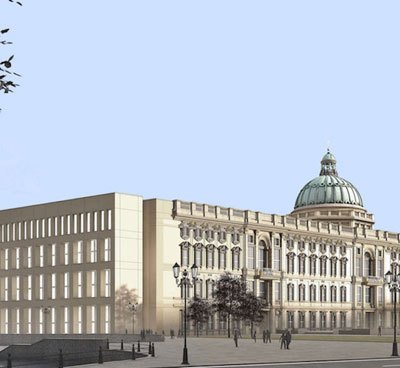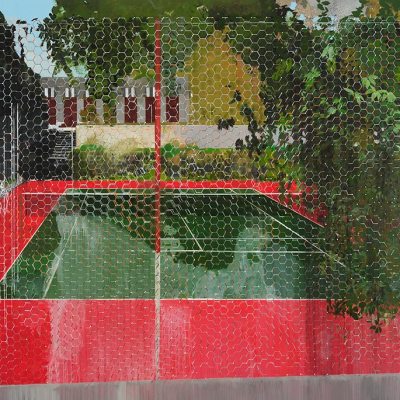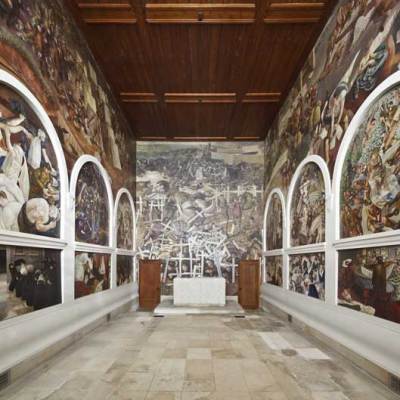A retrospective of Hubert Robert (1733–1808) is a tricky proposition. On the one hand, how to do justice to the different facets of his career, balancing his painting with his skills as garden-designer, interior decorator, and museum administrator? On the other, how to deal with the sameness of a corpus of works that defies notions of linear progression? Electrified by his encounter with the antique, Robert quickly built up a repertoire of architectural elements and stock human types. While the age and significance of the ruins he treated varied over the next 40 years – from the Colosseum, to the Opéra, to the Bastille – his motifs did not evolve but were obsessively recycled. How to reveal these continuities without falling into the trap of monotony?
The Bastille in the early days of its demolition, 20 July 1789, Hubert Robert. Musée Carnavalet, Paris
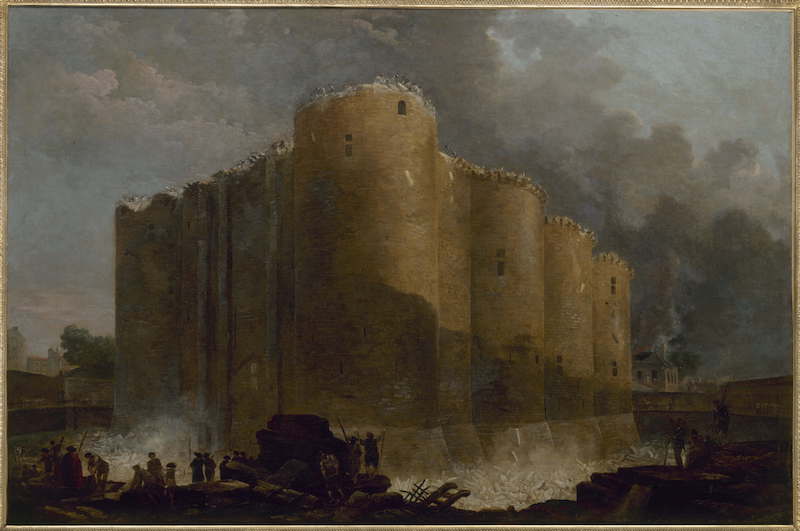
Laid out on a vast scale, the exhibition ‘Hubert Robert: A Visionary Painter’ – which travels to the National Gallery of Art, Washington D.C. this month – manages to turn the circularity of Robert’s work into an asset. Each room offers a deepening of visual ideas formulated in his Roman heyday, revealing his suppleness in adapting existing imagery to new circumstances. Take the ominous Young Girls Dancing around an Obelisk, on loan from Montreal. Painted in 1798, in the shadow of the Egyptian expedition, it invites meditation on transience and decay. Yet this standard theme acquires extra intensity when translated to this mysterious desert setting, with its dissected sphinx and encrusted hieroglyphs. The temporality is perplexing, even illegible, centred on a circle of dancing neoclassical maidens: is this a glorification of Napoleonic arms, or an allegory on the destiny of empires? In the corner we spot two adults earnestly pointing out the broken stones for the instruction of a child; but what exactly the ruins might teach remains indecipherable.
Time flows oddly in Robert’s universe. In an important recent book, Nina Dubin ingeniously connected his interest in fragile structures to the speculative financial markets that underwrote the wealth of his patrons. Eighteenth-century France was built on credit, risk, and the whims of fashion. Exposed to the hazards of popularity, Robert was acutely sensitive to historical change. The exhibition amply documents Robert’s abiding fascination with both the process of construction – from the Trevi fountain under scaffolding, to the tents pitched on the Champ de Mars in 1790 – and with buildings in a state of abandon or collapse. Time, to that extent, appears an inexorable, irreversible, force. Yet Robert elsewhere embraced anachronism, allowing the inhabitants of antiquity and modernity to collide and scrutinise each other. In a ravishing 1786 watercolour for the comtesse d’Angiviller, two fashionable modern women are absorbed in sketching antique fragments, while exerting their own fascination upon two men in togas, peering from rocks above.
The Winding Stairway in Palazzo Farnese in Caprarola (1864), Hubert Robert, Musée de Valence. Photo: Philippe Petiot

The first half of the exhibition is dominated, rightly, by Robert in Italy. The Roman years furnished Robert with the friends, collectors, and artistic influences that set up his subsequent career. Through his teacher Panini he came to see antiquity as a virtual museum, a storehouse of statuary that he could reorder into endless combinations. Through his other Italian mentor, Piranesi, he learned to construct disconcerting vistas through the cityscape, turning the urban fabric into an optical puzzle. These visual effects are best appreciated in the series of sanguines and watercolours which are the highlight of the early rooms. In these works in red chalk Robert’s sensualism and spontaneity (sharpened by his relationship with Fragonard) jostled alongside architectural volumes and a powerfully geometric conception of space.
The exhibition makes clear that for Robert, archaeological exactitude always came second to visual effects. While he loved antiquity, he was unafraid to stretch, shrink, or geographically relocate its celebrated monuments in order to create arresting sensations. A lover of the theatre, Robert had a clear taste for spectacle, and the curators have done this full justice in a modest room bursting with sublime views. Robert’s 1779 painting of the Tivoli cascade apparently inspired a sweet feeling of tragedy in its patron Grandcourt, as a cluster of three figures stare in rapt fascination over the vast empty expanse of water and crags.
Landscape with Waterfall inspired by Tivoli (1779), Hubert Robert. Château de Maisons, Maisons-Laffitte. © Patrick Cadet/Centre des monuments nationaux
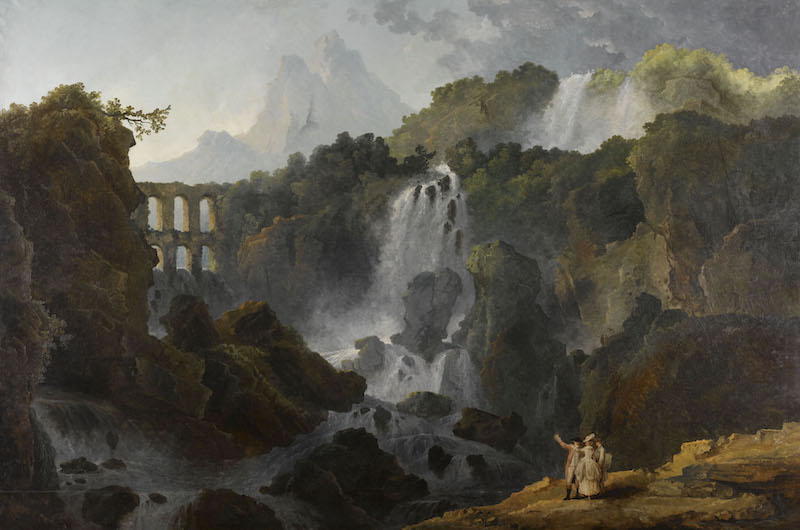
So far, so familiar. Yet in the second half of the exhibition, the curatorial team challenge perceptions of Robert by revealing hitherto underappreciated talents. Here is Robert the admirer of medieval fortifications, as glimpsed at La Roche-Guyon or the Château de Gaillon; Robert the tender chronicler of family life; Robert the horticultural impresario; even the exotic Robert, with a fictional scene from the Guiana penal colony. Most unexpected, perhaps, are the artefacts he designed for the royal dairy at Rambouillet. While sitting on an Etruscan chair crafted by Jacob, or employing a bovine Sevrès service decorated by Lagrenée, Marie-Antoinette could have sipped from a bizarre bol des seins, in which the chalice took the form of a bare milky-white breast.
These rooms testify not just to Robert’s versatility, but also his earthy humour. The Roman compositions already evinced a comical discord between solemn ruins and modern-day mischief. The denizens of 18th-century Italy – heedless fishmongers, urinating children, or the ubiquitous scampering dogs – appear blithely indifferent to their civilisational inheritance. But the tone is not censorious; rather, Robert delighted in playing the frozen deities of antiquity off against contemporary, flesh-and-blood foibles. The curators suggest persuasively that the diminutive characters who throng Robert’s paintings prove his credentials as a painter of genre. For instance, the labourers, soldiers, and elegant courtiers who negotiate the felled tree-trunks near the Bosquet des Bains d’Apollon are painted with such meticulousness and sympathy that we can understand Diderot’s comparisons to Chardin.
The revolutionaries viewed Robert with suspicion; his career depended entirely on the connoisseurs who delighted in his erudite fantasies. These nobles with a taste for ruins – such as Jean-Joseph de Laborde, creator of Méréville, or the baron de Breteuil, collector of scenes of Parisian demolition – would lose their property (and sometimes their heads) in the general ruination of the privileged orders. Robert used his imprisonment after 1793 to perfect his art of everyday observation. The scenes he produced in Sainte-Pélagie and Saint-Lazare are touchingly humdrum; he painted his dinner plates with pastoral scenes, and doodled his own self-portrait on the reverse. His dispatches from the prisons of the Terror exude a surprising air of serenity, even homeliness. In his submissions to the 1796 Salon – pairing the Louvre as a beacon of democratic education, with the Louvre as a charred, roofless wreck – Robert affirmed the indestructibility of beauty, defying the political cataclysm. But this revelatory exhibition also suggests the comfort he found in the labours of ordinary people, the insouciant moderns who cavort amid the ruins.
From the June issue of Apollo: preview and subscribe here
‘Hubert Robert: A Visionary Painter’ is at the National Gallery of Art, Washington, from 26 June–2 October.

